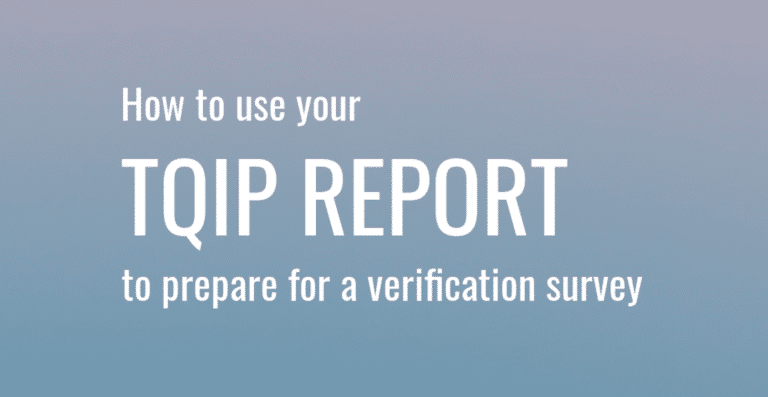The American College of Surgeons recently announced several major changes to the trauma center verification process. One significant development is that data from the Trauma Quality Improvement Program (TQIP) will play a greater role in verification site visits. For trauma program leaders, this change presents both challenges and opportunities.
On one hand, ACS reviewers will soon have access to much more of your program’s TQIP data. This will give reviewers a deeper view of your center’s performance issues and weaknesses. On the other hand, the focus on TQIP will enable trauma program leaders to prepare more effectively for their site visit.
The key to using TQIP to prepare for a site review is to master your semiannual benchmark report. Trauma program leaders can use their reports to identify the issues that reviewers are most likely to focus on during a verification review. Program leaders can also use TQIP to plan and demonstrate more effective management of performance issues.
Use TQIP reports to anticipate potential survey issues
For several years, ACS reviewers have had access to summary TQIP results for the trauma centers they surveyed. Under the new standards, surveyors will receive a copy of a center’s full TQIP benchmark report before a review. That means any care concerns discernible in your benchmark report could become the center of attention at your next site survey.
The good news is that trauma program leaders can use their TQIP results to focus their survey preparation efforts. The key is to understand the major “signals” that are built into the TQIP report:
Box plots. The basic concept of the TQIP box decile figure is clear — a red diamond indicates that your center is a high outlier for a particular outcome in a particular patient cohort. It is a clear signal that you have an opportunity for improvement (OFI) and an issue that should be addressed before your next review.

But what if your TQIP report does not include any high outliers? I often hear some version of the following statement: “We don’t have any red diamonds — all is good!” Actually, this view is off-target. Say your odds ratio for mortality in shock patients is in the 75th percentile and the median odds are within the confidence interval. Yes, your outcomes for this cohort are in the “acceptable” range, but are you really content to be doing worse than three-quarters of your peers?
An outside observer (like an ACS site reviewer) could reasonably see this issue as an OFI. Depending on what other performance issues your center may be facing, your care for shock patients could easily become a focus of your next site review.
Trend charts. The TQIP report also includes four trend charts that show performance over time on your center’s major indicators. This is another opportunity to look beyond the red diamonds and identify opportunities to do better.
For example, your unplanned ICU admission rate is in line with your peers, but it has been trending up for the last three reporting periods. Although your outcomes on this cohort are “acceptable” they are clearly worsening. This is a signal to take action and address this concern before your next survey.
One note: When exploring any outlier result or reporting period fluctuation in your TQIP report, your first step should always be to validate the data.
- Drill down: Use the TQIP driller to access the patient list for the affected cohort.
- Compare records: For each patient, compare the TQIP submission to the corresponding trauma registry record.
- Fix the data: If you suspect gaps in the record or coding errors, re-abstract the patient charts. In addition, run a registry report to identify any eligible patients who were not included in the TQIP submission. If possible, re-abstract these patient records to resolve inclusion issues.
- Re-submit: If registry corrections were significant, it may make sense to resubmit patient data to TQIP.
Validating and correcting your data may show that your outcomes are actually in line with your peers. However, if the outlier result remains after data validation, you know you have an issue to resolve.
Use TQIP reports to investigate and resolve OFIs
Once you have used the box plots and trend charts to identify possible issues, use the remainder of the TQIP report to explore and validate the OFI. The main tools are the process of care and hospital event tables and the TQIP driller.
For example, say your report shows that risk-adjusted mortality for shock patients is an area of concern. First, use the driller to access the patient list. Second, comb through the tables to identify commonalities within this cohort:
- Check the patient characteristics tables. Looking at Table 7, you note that the mean age of your shock cohort is significantly higher than the mean for all TQIP hospitals. Further down in Table 9, you learn that fall injuries are over-represented, further evidence that this might be a geriatric care issue.
- Check the in-hospital events tables. Scrolling through Table 12, you see that your hospital event rates for shock patients are largely in line with other TQIP centers. The one exception is pulmonary embolism (PE), which appears to be a significant issue for this cohort.
- Check the processes of care tables. Looking further into your PE care, your next stop is Table 23. You find that your VTE prophylaxis rate for shock patients is in line with national benchmarks. However, days to VTE prophylaxis for shock patients is more than double the national median.
There are a lot of ways to look at these data, and the above steps are a simplified version of the TQIP thought process. However, one question that comes to mind is whether your center has a clinical practice guideline for managing geriatric VTE prophylaxis.
If the answer is no, then the right plan for correcting this issue might be to update (or adopt) practice management guidelines for VTE prophylaxis. Remember, a corrective action alone is not loop closure. You will need to audit for compliance to ensure the issue has been resolved in order to close the loop.
Preparing for a site visit is a lot like grade school math — you need to “show your work.” Even if your TQIP data indicates that you resolved a problem, site reviewers will still want to see documented evidence of issue identification, action plans and loop closure.
I recommend using a simple documentation tool like the Plan-Do-Study-Act (PDSA) format to summarize your work on each PI project. The result is an easy-to-follow one-page document that includes the problem statement, interventions, data analysis showing progress, and evidence of loop closure.
Remember, you do not have to resolve every PI issue before your site survey. You just have to demonstrate that you are working on it. Even if you have not yet achieved loop closure, use PDSA documentation to highlight the progress towards that goal.
Use TQIP reports to prepare for the survey chart review
If you use the above process to identify and resolve your major OFIs, you will be well prepared for just about any PI issue that ACS reviewers raise during your survey. However, it also makes sense to use your TQIP report to prepare specifically for the chart review.
For example, one category of the ACS medical chart request is unexpected return to the OR or ICU. Your team identifies 10 charts in this category and provides them to ACS reviewers as normal. Instead of stopping there, you can then use your TQIP benchmark report to understand and evaluate the care your center provided to these patients.
Access the patient list for Unplanned Return to OR and identify any potential quality issues that might have contributed to this outcome. This process may or may not uncover an OFI. Either way, however, it will help prepare your team to have an informed discussion about these charts during your medical record review.
Two additional recommendations
There are two more things you can do to make sure your TQIP report is an effective tool for preparing for a verification survey.
First, monitor your TQIP inclusion rate. What percentage of all the patients in your trauma registry were accepted by TQIP? In some centers, inclusions are less than one-third of total trauma admissions. In my experience, this often goes unnoticed by trauma program leaders.
If you have a low inclusion rate either overall or for specific patient cohorts, drill down and determine what issues are preventing patients from getting into the submission. Common issues include documentation problems and AIS coding errors. Working with physicians and registrars to resolve these obstacles will help ensure you get more out of your TQIP benchmark reports.
Second, add TQIP indicators to your program’s PI dashboard. Include major TQIP categories such as acute kidney injury, ventilator-associated pneumonia, pulmonary embolism, surgical site infection, unplanned admission to the ICU, unplanned return to OR, and catheter-associated UTI. In addition, consider adding metrics from the TQIP process of care tables.
Adding these metrics to your dashboard is a great way to maintain concurrent review of the identified issues, implement corrective actions in a timely manner and develop preventive strategies. This approach will also help make sure there are no surprises in your next TQIP report.
Angie Chisolm, MBA, BSN, RN, CFRN, TCRN is managing partner at Peregrine Health Services. She is a nationally recognized expert in trauma program operational efficiency, coding and billing, site survey readiness and performance improvement. Angie is also chief operating officer and co-founder of National Quality Systems (NQS), a data management platform for trauma centers.

